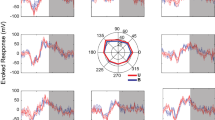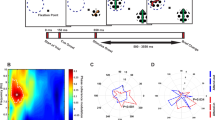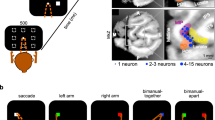Abstract
High-frequency oscillations in the beta range (10–45 Hz) are most active in motor cortex during motor preparation and are postulated to reflect the steady postural state or global attentive state of the animal. By simultaneously recording multiple local field potential signals across the primary motor and dorsal premotor cortices of monkeys (Macaca mulatta) trained to perform an instructed-delay reaching task, we found that these oscillations propagated as waves across the surface of the motor cortex along dominant spatial axes characteristic of the local circuitry of the motor cortex. Moreover, we found that information about the visual target to be reached was encoded in terms of both latency and amplitude of evoked waves at a time when the field phase-locked with respect to the target onset. These findings suggest that high-frequency oscillations may subserve intra- and inter-cortical information transfer during movement preparation and execution.
This is a preview of subscription content, access via your institution
Access options
Subscribe to this journal
Receive 12 print issues and online access
$209.00 per year
only $17.42 per issue
Buy this article
- Purchase on Springer Link
- Instant access to full article PDF
Prices may be subject to local taxes which are calculated during checkout








Similar content being viewed by others
References
Sanes, J.N. & Donoghue, J.P. Oscillations in local field potentials of the primate motor cortex during voluntary movement. Proc. Natl. Acad. Sci. USA 90, 4470–4474 (1993).
Baker, S.N., Kilner, J.M., Pinches, E.M. & Lemon, R.N. The role of synchrony and oscillations in the motor output. Exp. Brain Res. 128, 109–117 (1999).
Gilbertson, T. et al. Existing motor state is favored at the expense of new movement during 13–35 Hz oscillatory synchrony in the human corticospinal system. J. Neurosci. 25, 7771–7779 (2005).
Pfurtscheller, G., Graimann, B., Huggins, J.E., Levine, S.P. & Schuh, L.A. Spatiotemporal patterns of beta desynchronization and gamma synchronization in corticographic data during self-paced movement. Clin. Neurophysiol. 114, 1226–1236 (2003).
Pfurtscheller, G., Krausz, G. & Neuper, C. Mechanical stimulation of the fingertip can induce bursts of beta oscillations in sensorimotor areas. J. Clin. Neurophysiol. 18, 559–564 (2001).
Pfurtscheller, G., Neuper, C., Brunner, C. & da Silva, F.L. Beta rebound after different types of motor imagery in man. Neurosci. Lett. 378, 156–159 (2005).
Donoghue, J.P., Sanes, J.N., Hatsopoulos, N.G. & Gaál, G. Neural discharge and local field potential oscillations in primate motor cortex during voluntary movements. J. Neurophysiol. 79, 159–173 (1998).
Murthy, V.N. & Fetz, E.E. Coherent 25- to 35-Hz oscillations in the sensorimotor cortex of awake behaving monkeys. Proc. Natl. Acad. Sci. USA 89, 5670–5674 (1992).
Murthy, V.N. & Fetz, E.E. Oscillatory activity in sensorimotor cortex of awake monkeys: synchronization of local field potentials and relation to behavior. J. Neurophysiol. 76, 3949–3967 (1996).
Murthy, V.N. & Fetz, E.E. Synchronization of neurons during local field potential oscillations in sensorimotor cortex of awake monkeys. J. Neurophysiol. 76, 3968–3982 (1996).
O'Leary, J.G. & Hatsopoulos, N.G. Early visuomotor representations revealed from evoked local field potentials in motor and premotor cortical areas. J. Neurophysiol. 96, 1492–1506 (2006).
Ermentrout, G.B. & Kleinfeld, D. Traveling electrical waves in cortex: Insights from phase dynamics and speculation on a computational role. Neuron 29, 33–44 (2001).
Delaney, K.R. et al. Waves and stimulus-modulated dynamics in an oscillating olfactory network. Proc. Natl. Acad. Sci. USA 91, 669–673 (1994).
Lam, Y.-W.L., Cohen, L.B., Wachowiak, M. & Zochowski, M.R. Odors elicit three different oscillations in the turtle olfactory bulb. J. Neurosci. 20, 749–762 (2000).
Friedrich, R.W., Habermann, C.J. & Laurent, G. Multiplexing using synchrony in the zebrafish olfactory bulb. Nat. Neurosci. 7, 862–871 (2004).
Senseman, D.M. & Robbins, K.A. High-speed VSD imaging of visually evoked cortical waves: decomposition into intra- and intercortical wave motions. J. Neurophysiol. 87, 1499–1514 (2002).
Prechtl, J.C., Cohen, L.B., Pesaran, B., Mitra, P.P. & Kleinfeld, D. Visual stimuli induce waves of electrical activity in turtle cortex. Proc. Natl. Acad. Sci. USA 94, 7621–7626 (1997).
Robbins, K.A. & Senseman, D.M. Extracting wave structure from biological data with application to responses in turtle visual cortex. J. Comput. Neurosci. 16, 267–298 (2004).
Senseman, D.M. & Robbins, K.A. Modal behavior of cortical neural networks during visual processing. J. Neurosci. 19, RC3 (1999).
Wang, W., Campaigne, C., Ghosh, B.K. & Ulinski, P.S. Two cortical circuits control propagating waves in visual cortex. J. Comput. Neurosci. 19, 263–289 (2005).
Du, X., Ghosh, B.K. & Ulinski, P. Encoding of motion targets by waves in turtle visual cortex. IEEE Trans. Biomed. Eng. 53, 1688–1695 (2006).
Contreras, D. & Llinas, R. Voltage-sensitive dye imaging of neocortical spatiotemporal dynamics to afferent activation frequency. J. Neurosci. 21, 9403–9413 (2001).
Wu, J.Y., Guan, L. & Tsau, Y. Propagating activation during oscillations and evoked responses in neocortical slices. J. Neurosci. 19, 5005–5015 (1999).
Chervin, R.D., Pierce, P.A. & Conners, B.W. Periodicity and directionality in the propagation of epileptiform discharges across neocortex. J. Neurophysiol. 60, 1695–1713 (1988).
Chagnac-Amitai, Y. & Conners, B.W. Horizontal spread of synchronized activity in neocortex and its control by GABA-mediated inhibition. J. Neurophysiol. 61, 747–758 (1989).
Muakkassa, K.F. & Strick, P.L. Frontal lobe inputs to primate motor cortex: evidence for four somatotopically organized 'premotor' areas. Brain Res. 177, 176–182 (1979).
Kurata, K. Corticicortical inputs to the dorsal and ventral aspects of the premotor cortex of macaque monkeys. Neurosci. Res. 12, 263–280 (1991).
Cauller, L.J., Clancy, B. & Connors, B.W. Backward cortical projections to primary somatosensory cortex in rats extend long horizontal axons in layer I. J. Comp. Neurol. 390, 297–310 (1998).
Luppino, G. & Rizzolatti, G. The organization of the frontal motor cortex. News Physiol. Sci. 15, 219–224 (2000).
Luppino, G., Matelli, M., Camarda, R.M. & Rizzolatti, G. Corticocortical connections of area F3 (SMA-proper) and area F6 (pre-SMA) in the macaque monkey. J. Comp. Neurol. 338, 114–140 (1993).
Ghosh, S. & Gattera, R. A comparison of the ipsilateral cortical projections to the dorsal and ventral subdivisions of the macaque premotor cortex. Somatosens. Mot. Res. 12, 359–378 (1995).
Dum, R.P. & Strick, P.L. Frontal lobe inputs to the digit representations of the motor areas on the lateral surface of the hemisphere. J. Neurosci. 25, 1375–1386 (2005).
Scott, S.H. Apparatus for measuring and perturbing shoulder and elbow joint positions and torques during reaching. J. Neurosci. Methods 89, 119–127 (1999).
Muthukumaraswamy, S.D. & Johnson, B.W. Primary motor cortex activation during action observation revealed by wavelet analysis of the EEG. Clin. Neurophysiol. 115, 1760–1766 (2004).
Quyen, M.L. et al. Comparison of the Hilbert transform and wavelet methods for the analysis of neuronal synchrony. J. Neurosci. Methods 111, 83–98 (2001).
Fleet, D.J. & Jepson, A.D. Computation of component image velocity from local phase information. Int. J. Comput. Vis. 5, 77–104 (1990).
Percival, D.B. & Walden, A.T. Spectral Analysis for Physical Applications: Multitaper and Conventional Univariate Techniques (Cambridge University Press, Cambridge, UK, 1993).
Cover, T. Elements of Information Theory (John Wiley & Sons, New York, 1991).
Acknowledgements
We thank Z. Haga, D. Paulsen and J. Reimer for help with surgical implantation of the arrays, training of monkeys and data collection. We also thank M. Fellows, E. Gunderson and R. Penn for help with surgical procedures. This work was supported by a grant from the Whitehall foundation and a grant R01 NS45853-01 from the US National Institute of Neurological Disease and Stroke, both awarded to N.G.H. K.A.R. received support from a Research Centers in Minority Institutions grant 2G12RR1364-06A1 from the National Center for Research Resources at the US National Institutes of Health.
Author information
Authors and Affiliations
Corresponding author
Ethics declarations
Competing interests
N.G.H. is a co-founder, board member, and stock holder in a public company, Cyberkinetics Neurotechnology Systems. This company provided the multi-electrode arrays and data acquisition system used in the study reported in the manuscript.
Supplementary information
Supplementary Fig. 1
Beta wave characteristics persist during movement (one second of movement). (PDF 350 kb)
Supplementary Fig. 2
Comparison between the singular value decomposition (SVD) and Hilbert transform methods for analyzing wave propagation. (PDF 152 kb)
Rights and permissions
About this article
Cite this article
Rubino, D., Robbins, K. & Hatsopoulos, N. Propagating waves mediate information transfer in the motor cortex. Nat Neurosci 9, 1549–1557 (2006). https://doi.org/10.1038/nn1802
Received:
Accepted:
Published:
Issue Date:
DOI: https://doi.org/10.1038/nn1802
This article is cited by
-
Beta traveling waves in monkey frontal and parietal areas encode recent reward history
Nature Communications (2023)
-
Parabolic avalanche scaling in the synchronization of cortical cell assemblies
Nature Communications (2023)
-
Tool use acquisition induces a multifunctional interference effect during object processing: evidence from the sensorimotor mu rhythm
Experimental Brain Research (2023)
-
A hybrid biological neural network model for solving problems in cognitive planning
Scientific Reports (2022)
-
Neural oscillations during motor imagery of complex gait: an HdEEG study
Scientific Reports (2022)



